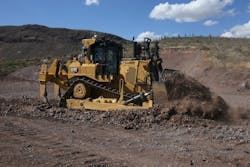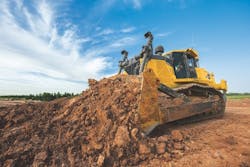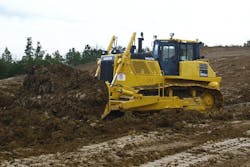How to Choose a Large Dozer
Crawler dozers 300 horsepower and over are staples in heavy-duty earthmoving and mining applications, usually facing high-production expectations but often suffering extra wear due to abrasive or rocky conditions.
Managers are tasked with balancing production requirements and operating costs with maintenance needs and component and machine life. Large crawler dozer makers and their dealers are ready resources, offering advice on configuration and cost savings through maintenance, technology, and more.
How to configure a bulldozer
One of the most obvious questions is what kind of big dozer is needed? There are options for the front and back of the unit, as well as the technology, and there are only a handful of manufacturers making large crawlers.
“Choose the right size of dozer with the right attachments, like blades, ripper, and undercarriage. All too often it seems [buying] a replacement dozer is a ‘copy and paste’ exercise without really understanding the needs,” says Caterpillar’s large dozer application specialist, Todd Cole. “You can never optimize your cost if the wrong size of dozer/blade/ripper combination is purchased.”
Charles Murawski, dozer product manager for Komatsu, says moving massive amounts of material in high-production applications requires managers to specify the proper front and rear attachments, and undercarriage, to suit job site conditions.
“For the front attachment, a semi-U or Sigmadozer blade should be selected for bank material that can be slot dozed or for the greatest versatility in general dozing work,” Murawski says. “In materials that heap up, the Komatsu Sigmadozer blade can increase productivity by up to 15 percent over semi-U. For looser material such as sand and gravel, a full-U blade should be considered. Special applications with low-density material like coal, woodchips, and waste require a blade with an extra-large capacity—two to three times standard capacity.”
Although the rear attachment on a large dozer is typically a ripper, Murawski points out a counterweight or towing winch may be selected if ground conditions are relatively soft and won’t require ripping before dozing.
“The undercarriage track shoe width should be as narrow as practical,” he says. “On firm ground, select 24- to 26-inch-wide shoes. For soft ground conditions, Komatsu’s D155AX-8 LGP with 38-inch-wide track shoes will provide optimum flotation.”
Undercarriage costs on dozers
The biggest factor in keeping operating costs down for large dozers is maintenance. Manufacturers key in on undercarriage care, as the undercarriage is universally considered a crawler’s most substantial expense.
4 tips for undercarriage care.
“When it comes to getting the most life out of the undercarriage, we can’t overlook the fundamentals,” says John Deere’s solutions marketing manager for roadbuilding, Matt Goedert. “First is track tension. Maintaining proper track tension is an important, controllable factor in undercarriage life. A tight track greatly increases component stresses and increases wear rates; however, running the tracks too loose will also reduce the life of the undercarriage components and cause uneven wear on the sprockets. Tracks should be adjusted to the proper amount of sag; this procedure is shown on every John Deere dozer located on the periodic maintenance chart decal.
“Track tension should be monitored regularly, especially when soil conditions change,” Goedert says. “Increased soil moisture, for example, can cause packing in the sprockets and a tighter track. It’s important to make sure your machine is properly configured for the application. In this example, recessed sprocket segments and track shoes with trapezoidal holes would be beneficial in getting more life out of the undercarriage because both options help reduce packing of material and allow a path for material to escape.”
Caterpillar’s Cole agrees that dirt in the wrong areas can be a problem, leading to premature wear. “There is no replacement for a good daily walk-around and shoveling dirt off the roller frames,” Cole says.
“In an ideal world, all undercarriage components would wear equally,” Goedert says. “Depending on variables such as shop labor rates, part costs, and which undercarriage components are wearing the fastest, it may be most cost effective to turn the pins and bushings or it may make more sense to keep running the machine until the pins and bushings need to be replaced.
“Knowing the cost per hour of operation is key in making such decisions, and the John Deere dealer can help with this,” Goedert says. “If a pin and bushing turn is a cost-effective approach, regular inspections are critical to scheduling the time for that service. Generally, larger crawlers are more likely to be better candidates for pin and bushing turns due to part costs. If the track links have around 50 percent wear and the bushings are at 90 percent worn, for example, a pin and bushing turn could maximize the life and return on investment on that undercarriage.”
Large crawler dozer OEMs offer extended-life undercarriages for more difficult and abrasive applications. Managers must weigh their options here.
“We offer our extended-life undercarriage option on our 850L, 950K, and 1050K dozers,” Goedert says. “This option decreases bushing wear by 50 percent over a standard bushing, which can greatly reduce operating costs and allow customers to get the most life out of their undercarriage components. Depending on wear rates of the various components, the decision to run until replacement is needed may be a clearer choice.”
Komatsu says its PLUS rotating bushing undercarriage can extend life up to twice the life of conventional without requiring a pin and bushing turn. Caterpillar’s Heavy-Duty Extended Life undercarriage has a 20- to 40-percent longer wear life and longer seal life to give “the best cost per bank cubic meters of material moved,” says Cole.
Dozer grade control
Utilizing manufacturers’ telematics systems is another way to find cost savings. One example is Komatsu’s new My Komatsu customer portal, which provides a number of fleet-management tools the company says can help maximize dozer value while being proactive about machine health.
“[You can] receive email alerts for excessive engine idle time, fuel consumption, or DPF regeneration,” Murawski says. “Also, view machine operation settings, machine usage, maintenance, cautions, and abnormality information, as well as determine remaining warranty coverage while finding the correct replacement parts with pricing for your specific machine. It’s also possible to place orders on the spot.”
Finally, operating habits and tech use play a role, as available grade-control systems can help operators achieve greater accuracy faster, eliminating extra passes and saving fuel.
Liebherr calls its grade-control offerings “Operator Assistance Systems” available in three levels: Free Grade for active shield stabilization during fine grading, Definition Grade for automatic blade positioning when creating 2D surfaces, and a 3D Grade option that offers a factory-mounted GPS machine control from Topcon, which is fully integrated and calibrated. Kits are also available for retrofitting of the latest 2D and 3D control systems from Trimble and Leica.
“Having well-trained operators [is important]; also ensure that travel speeds are low and reverse travel is minimal,” recommends Liebherr’s Nick Rogers, product specialist and inside sales coordinator for the construction equipment division.
The Intelligent Machine Control system (IMC) from Komatsu is designed to enable a relatively inexperienced operator to perform high-quality precise work to within ±1.2 inches of design target. “The system can be run in the auto-mode from first pass to the final finish pass,” Murawski says. “Blade load is automatically adjusted by IMC to reduce track slip and wear. There are no antennas or cables on the blade. All IMC components are mounted on the base machine and well protected. Large savings can be realized from increased productivity, reduced surveying and staking, and fewer repairs to damaged components in an aftermarket grade control system.”
We Field Tested the Komatsu IMC dozer.
“JDLink, the John Deere telematics system, is also tool that can be utilized to lower operating costs,” says Goedert. “Through telematics, customers can monitor idle time, which is a large contributor to operating costs. Putting unnecessary hours on the machine will cause the machine’s warranty to expire quicker and reduce the value of the machine over its life.
“Using JDLink, you can also monitor operating characteristics such as forward versus reverse travel time, distance traveled, and travel speed,” Goedert says.
Caterpillar offers a variety of technologies on its D9 to D11: “AutoCarry, AutoRip, Grade 3D, Remote Control, Vision 360 camera system, and a powered access ladder that all contribute to keeping the operators safe, in control, and productive,” Cole says.
Cat tells Construction Equipment that all of its D9 to D11 models will soon offer a stator clutch torque convertor that has shown more than a 5-percent reduction in fuel consumption while still providing retarding capability for working on a slope.


